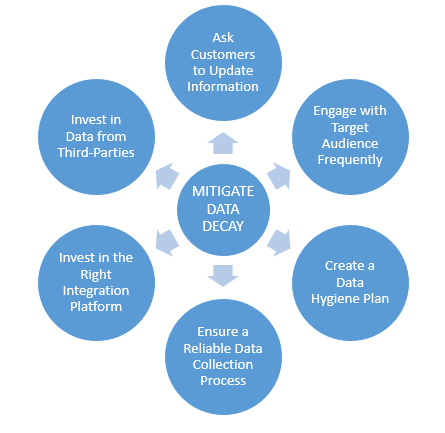Everything, including enterprise data, succumbs to the passage of time. As databases grow and diversify, a growing number of businesses are concerned about data decay. When a sales or prospecting contact list fails to reflect the fact that key personnel have changed roles or moved to a different firm, this is an example of data decay. Data decay can also happen when files aren’t correctly cataloged, especially when the people in charge of retiring a vintage data group aren’t even aware the asset exists.
In this post we’ll discuss 6 ways in which data quality can be rendered immune from decays:

6 Ways to Mitigate Data Decay
1. Ask your customers to update their information directly
While some customers will update their contact information on their own, the majority will require a polite reminder. You can invite your audience to update their contact information in a variety of ways. Brands can use a tab or pop-up to remind website visitors to “finish their profile” or to urge users to personalize their email preferences in an email preference center. An email preference center allows customers to select the kind of emails they get from brands as well as the frequency with which they receive them.
2. Engage with your target audience on a frequent basis and in a relevant way
Marketers may keep their current audience engaged with content that encourages them to update their contact information, preventing data degradation. Using opt-in or interactive content, such as contests, gated whitepapers or webinars, or amusing quizzes and polls, keeps CRM data up to date and allows you to acquire additional information on customers and prospects. Furthermore, regularly distributing relevant, useful information to an audience increases the likelihood of them engaging with a company on a deeper level and reduces the likelihood of them falling off the grid as their email addresses or social media handles change.
3. Create a Data Hygiene Plan
Data degradation is a big stumbling block for data management companies. It results in a financial loss, a loss of reputation, and a loss of goodwill. A database that is authentic, fresh, and one-of-a-kind is essential for every B2B company to stay competitive. As a result, data hygiene takes precedence over all other data management activities. Routine cleansing must follow a constant and cyclic flow of data updates to avoid data deterioration.
For continuing updates, validations, and cleansing of your data, use a delicate blend of human intelligence and automated solutions. For any B2B company’s growth and success, it’s vital to keep track of every change and new addition to the present data pool.
4. Ensure a reliable and efficient data collection process
Data resources are the most important component of effective data collecting and analysis. You must ensure the systems and individuals in charge of data and information generation are reliable and trustworthy.
Analyze and filter through the components that contribute to data collection, and determine which are the most important for the analysis or development of a feasibility or performance report for a certain task or operation. To establish a game plan for your data collecting, create a list of basic and vital metrics.
In the manual system of data entry and information recording, there is a lot of space for mistakes and human error. Due to personal biases and buddy favors, there is also a considerable chance of compromised and erroneous data entries, which could completely modify the inferences and conclusions, reducing the efficacy and portability of the data analysis and results. Data gathering via clever and automated solutions, such as Time and Attendance Software, allows managers to concentrate on other elements and parameters while the system collects real-time and accurate data in perfect harmony.
5. Invest in the right integrations to keep your data accurate
Data decay can be avoided by integrating with an easy data platform that delivers clean data directly into a brand’s CRM system. Integrating B2B lead data from a third-party data provider straight into a company’s CRM can save a lot of time and eliminate issues like erroneous or missing data and manual entry.
Data decay can be avoided by integrating with an easy data platform that delivers clean data directly into a brand’s CRM system. Integrating B2B lead data from a third-party data provider straight into a company’s CRM can save a lot of time and eliminate issues like erroneous or missing data and manual entry.
6. Invest in data from third-parties.
When it comes to filling in the gaps in a company’s data, third-party data is critical.
Third-party data providers collect information about prospects and customers from numerous channels, platforms, apps, and websites, offering information that a brand would not have access to based on their own interactions. Furthermore, because a credible data source will follow a strict data hygiene and verification process, brands can use third-party data to keep their records current.
Summary
Data decay is expensive. It has a detrimental influence on your client’s capacity to effectively communicate with current and potential customers, preventing business growth. To overcome it, businesses must maintain ongoing contact with their customers, maintain data integrity, and invest in technologies to keep their data fresh.


